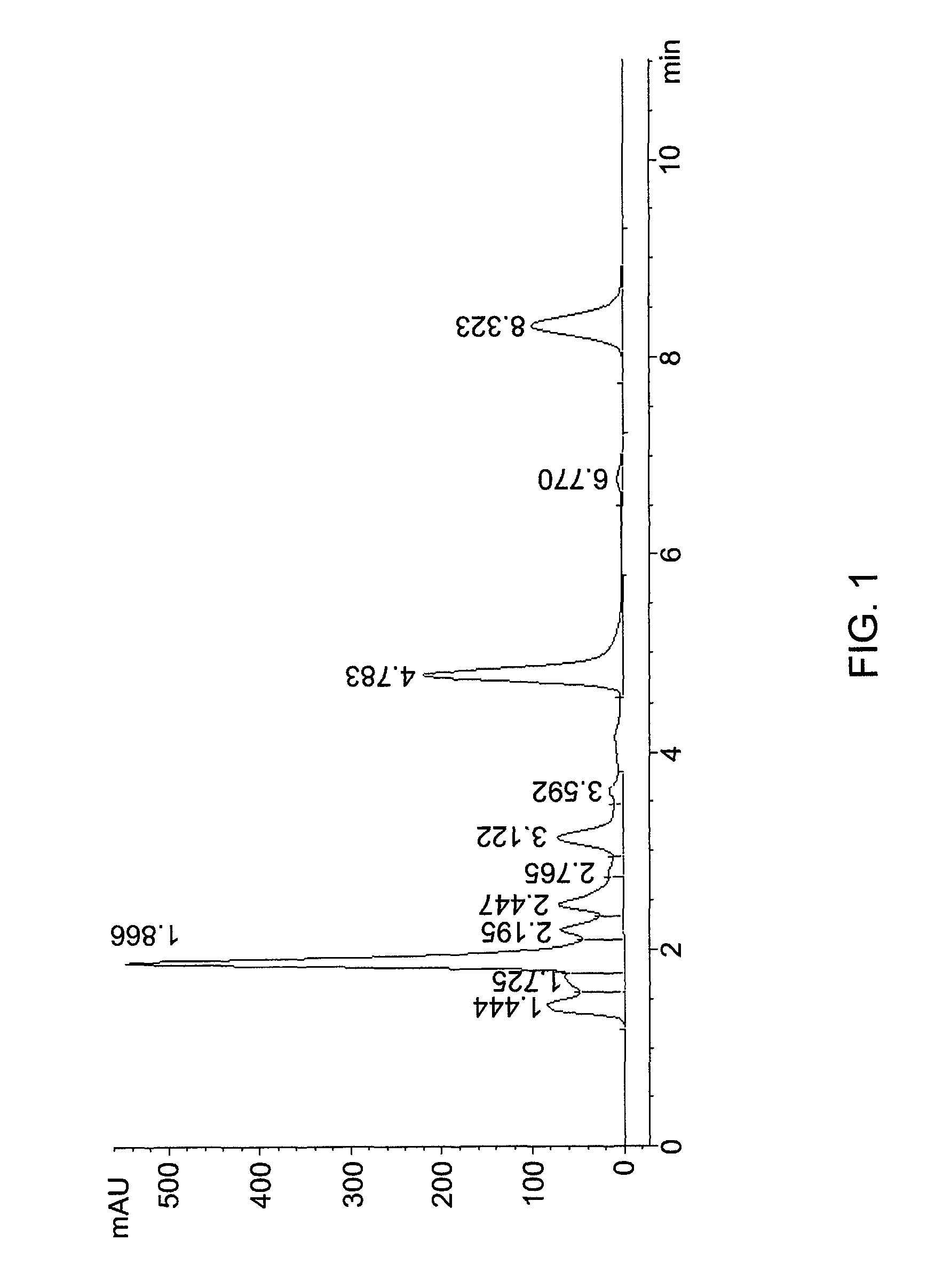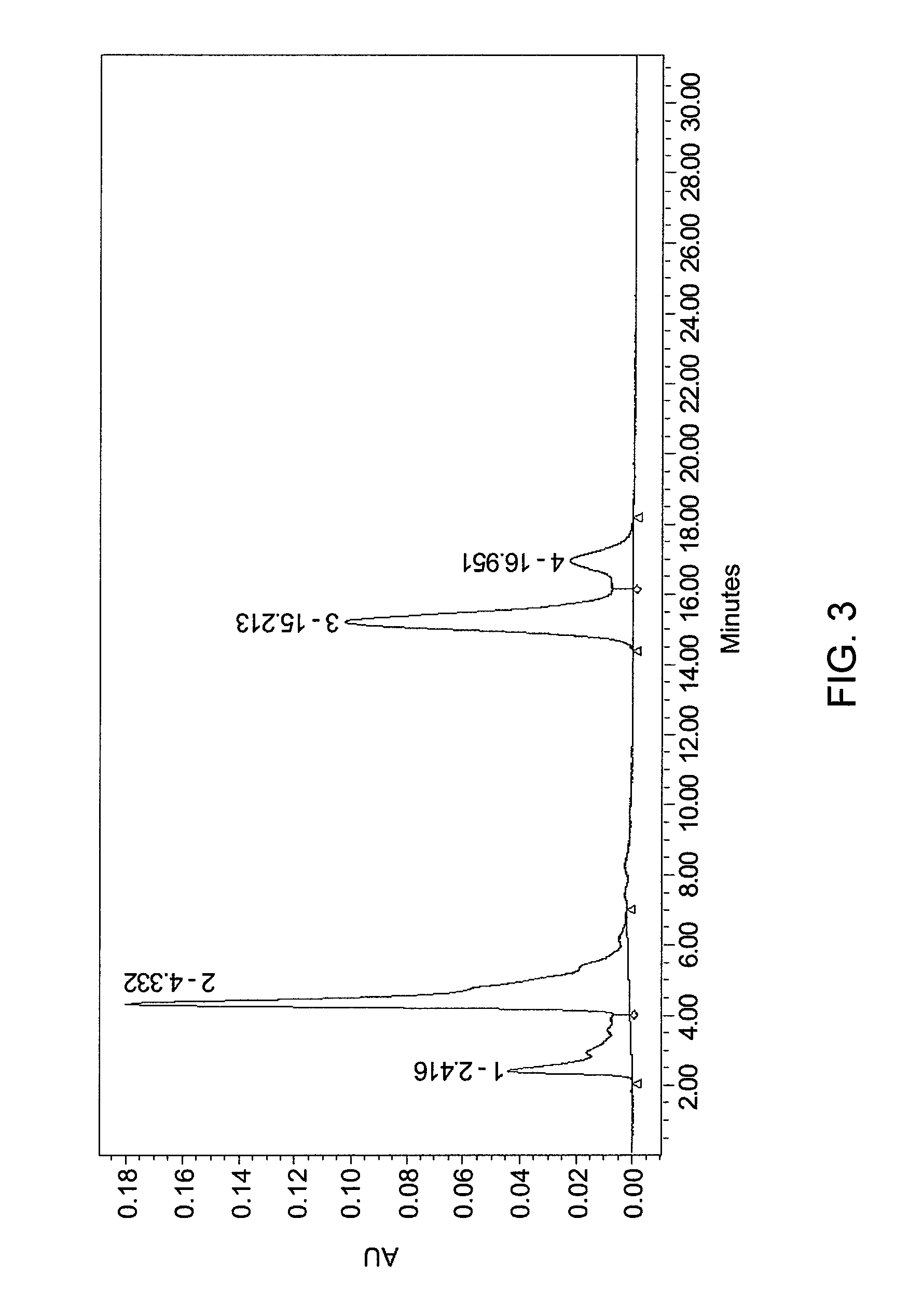Hydrolysate of crocin
a technology of crocin and saffron, which is applied in the field of crocin hydrolysate, can solve the problems of unsuitable crocin synthesis, large molecular structure of crocin, and small quantities of saffron go a long way in flavoring, and achieve the effect of enhancing brain health and lowering high cholesterol
- Summary
- Abstract
- Description
- Claims
- Application Information
AI Technical Summary
Benefits of technology
Problems solved by technology
Method used
Image
Examples
example 1
[0119]10 g gardenia yellow was dissolved in 20 g water and 8 g hydrochloric acid (35% by volume). The mixture was heated to 50° C. and reacted for 2.5 h with agitation under a nitrogen atmosphere. A dark red solid was washed by 200 mL water and then was dissolved in 200 mL methanol. The solution was filtered and the methanol was distilled to afford 3.1 g of a dark red solid.
HPLC Determination
[0120]HPLC analysis was performed with a Agilent1100 system equipped with a C-18 chromatographic column (75 mm×4.6 mm). AUV-Vis detector monitored the elution profile at 440 nm wavelength. The mobile phase was a solution consisting of 80% methanol and 20% water which contained 0.2% acetic acid.
[0121]The components of the red solid are specified in Table 1 below and in FIG. 1:
[0122]
TABLE 1Peak contentTimeAreaHeightWidthArea %SymmetryCrocin1.444967.683.90.1527.3861.092monoester of1.8664348.7544.20.116533.1920.599crocetinCrocetin4.7832505.8220.30.169119.1250.655others8.3231535.399.40.235511.7180.85...
example 2
Monoester of Crocetin Preparation (Test SN: C-0118PA)
[0123]600 g gardenia yellow (commercial product, UV %=20%, 422 nm) was mixed with 1800 g phosphoric acid and 1200 g water. The mixture was stirred at 75° C. for two hours. The resulting material was washed with 1200 mL water. After water washing, the end product weighed 600 g, and was a dark red solid. FIG. 1 and Table 2 provide components and relative amounts of components.
HPLC Analytical Method:
[0124]Instrument: Waters HPLC[0125]Column: RP18, 3.9 mm×150 mm×5 μm[0126]Mobile phase: methanol / water=80 / 20[0127]Flow rate: 0.5 mL / min[0128]Detection: 440 nm
[0129]
TABLE 2PeakNo.Peak contentRTArea% AreaHeight1Crocin2.457265245712.33716592Monoester of4.449938569543.63290442crocetin3other component7.6002839101.3239214other component8.867290410.1418675Crocetin 1*16.036774156835.991830946Crocetin 2*17.90114188106.6030594*Isomeric compound
[0130]The percentage of peaks are noted below:[0131]Crocin: 12.33%[0132]Monoester: 43.63%[0133]Crocetin: 41...
example 3
Monoester of Crocetin Preparation (Test SN: C-0117)
[0134]1 g gardenia yellow (commercial product, UV %=20%, 422 nm) was mixed with 20 g phosphoric acid aqueous solution (5% by weight). The mixture was stirred at 50° C. for 40 min, and then 4 g concentrated HCl and 1 g water were added to the reaction system drop by drop until complete. After vacuum filtration, the resulting material was resolved in ethanol to form a saturated solution. Water was added dropwise until precipitation occurred. The upper clear liquid was analyzed by HPLC. Analytical analysis was performed as in example 2. The results are provides in FIG. 3 and Table 3 as shown below:
[0135]
TABLE 3PeakNo.Peak contentRTArea% AreaHeight1Crocin2.416156718413.11437482Monoester of4.332540287745.20179077crocetin3Crocetin 1*15.213393204132.891021034Crocetin 2*16.95110514768.8021909*isomeric compound
[0136]Percentage of peaks are noted as:[0137]Crocin: 13.11%[0138]Monoester: 45.20%[0139]Crocetin: 41.69%.
PUM
| Property | Measurement | Unit |
|---|---|---|
| melting point | aaaaa | aaaaa |
| molecular weight | aaaaa | aaaaa |
| temperature | aaaaa | aaaaa |
Abstract
Description
Claims
Application Information
 Login to View More
Login to View More - R&D
- Intellectual Property
- Life Sciences
- Materials
- Tech Scout
- Unparalleled Data Quality
- Higher Quality Content
- 60% Fewer Hallucinations
Browse by: Latest US Patents, China's latest patents, Technical Efficacy Thesaurus, Application Domain, Technology Topic, Popular Technical Reports.
© 2025 PatSnap. All rights reserved.Legal|Privacy policy|Modern Slavery Act Transparency Statement|Sitemap|About US| Contact US: help@patsnap.com



